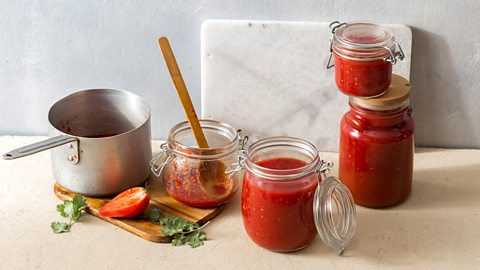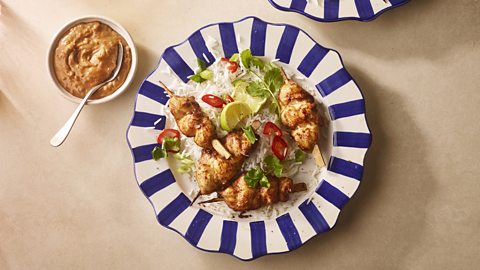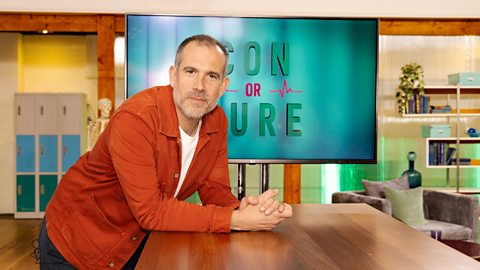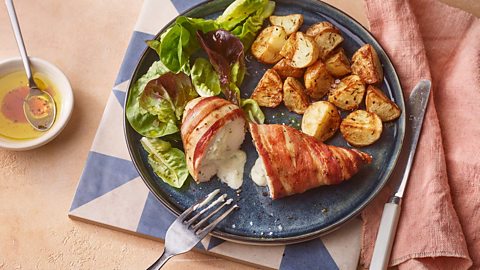How to make the best roast potatoes

by Poppy O'Toole
I like to think I was put on this earth with a purpose. And that purpose is potatoes. I’ve spent the last 18 months knee-deep in potato content – creating countless how-to recipes and videos from how to perfect your mashed potato to Pommes Anna to simple hash browns. In doing so, I have somehow amassed over 300 million views. Mind-boggling!
Some might say there are more important things to be passionate about, but let me tell you, it’s an incredibly useful passion to have. I’ve committed time and effort to discover what makes the perfect roast potato, and now it’s time to let you in on the secrets.
Let’s start by looking at some of the new tips and tricks that have come about in the last few years. These are the additions to the classic roastie that we’re told take the spud to the next level – whether that’s in taste, texture or appearance.
Bicarb in the boiling water
Some people advocate adding a teaspoon of bicarbonate of soda to the water during boiling to produce a crisper tattie. Bicarb will break down the surface of your potatoes, creating a starchier, softer exterior to your spuds that increases surface area for crunch. So do I personally bicarb? No. I’m an advocate for keeping things simple, letting the potato do the talking. A thorough boil should make a soft enough exterior and a fluffy interior. More on that later.
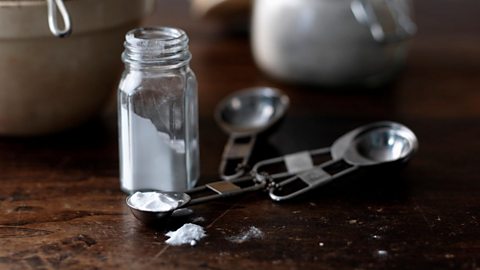
Overnight dry
Some people suggest that you leave your boiled spuds to dry overnight before you roast. This is because the best crunch is the result of the driest potato hitting the hot fat. It definitely works, but let’s be realistic. Unless you're super organised, it can be hard to find the time (or even to remember to), dry your spuds out the night before. It is however important to dry out your potatoes, but I think you can achieve this on the day with the help of a good ol’ colander and a tea towel.
Herbs and other aromatics
To achieve the perfect roast potato, it needs to be in the oven for a good amount of time, and a common error occurs when people herb up their potatoes too early. Garlic burns quickly, and rosemary even quicker, so add any herbs either toward the end of the roasting time or even after cooking, as a garnish. Now I love garlic, I love rosemary, but I also love potatoes. I’ll stand tall in saying the perfect roast potato doesn’t need the trimmings. It needs a potato, some oil/fat, seasoning and following the tips below. That’s all. Trust me.
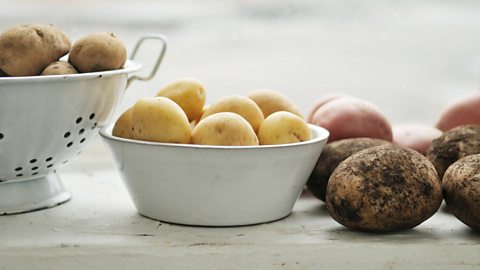
What potatoes are best for roasting?
It's all about choosing the right potato. I’ve tried my fair share of varieties in the quest to achieve the perfect roast potato. My go-to again and again? It’s the Maris Piper. It’s the perfect level of starchiness and sturdiness to nail that gorgeous crunch but still remains light and fluffy inside. I could go on about which potatoes suit which recipes, and I have, if you want the full discussion.
How big to cut the potatoes
Go for larger chunks of potato so that the sides are bigger. This means more potato will be in contact with your pan or tray, giving it more direct heat to crunch up. The perfect roast potato has a balance of fluff in the middle and crispy exterior. Cut them too small and they're crunchy, but too hard.
How long to boil potatoes before roasting
Put your potatoes into cold water and bring them to the boil. I was always taught, if it comes from the ground, boil it from cold. This can sound weird – surely going straight into hot water will speed up the cooking time? The issue you have is the size of a good ol’ spud. It needs more time to cook all of the way through as it’s dense. If you were to throw them straight into boiling water, your potatoes start to cook on the outside faster than the inside and no-one wants uneven tatties.
Heavily season your boiling water with salt. It adds flavour to the inside of your spud rather than just a seasoned outside later. Throw them in your seasoned water, and bring that water to boil, to allow more time to heat and salt to penetrate all the way through.
Use the ‘fall off the knife test’ to know when your potatoes are boiled enough. It will differ with potato choice, but it’s usually about 15 minutes after bringing the water to boil that you’ll want to check them. The knife test is just prodding a potato with a table knife and lifting the potato out of the water. If the potato is still connected to the knife, they’re not ready yet. If the potato falls off the knife, you’re good to move onto the next step!
I go for 15 minutes because, as stated, I go for a larger size of potato which will be able to take a bit more in the boil. Go big, or go home. It is also means that the insides are like actual mash in the middle by the time they’re finished. I'm hungry just thinking about it.
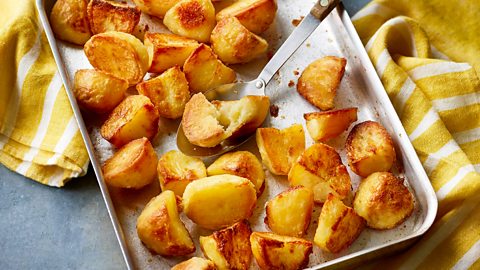
How to make roast potatoes crispy
It's all about the steam-dry; potentially the most important bit of achieving a crispy, crunchy spud without the need for any extras. Once you’ve finishing the boiling stage, drain your potatoes in a colander, place the colander back over the pan you’ve boiled them in and immediately cover them with a clean tea towel. This absorbs the steam, keeps the potatoes warm and gives them a bit of extra time to dry out on the outside. I’d normally leave them there for about 10-15 minutes before giving them a quick shake and moving on to the next stage.
Use this time to heat up your fat in the roasting tray before adding the potatoes. This pre-heating stage is equally important to get that crunch. In terms of choice of fat – for a normal roast dinner I’d use about three tablespoons of vegetable oil. For a special occasion, I might mix it up with some beef dripping, goose fat or duck fat.
Whatever you use, it’s so important to ensure you get the tray in a 220C/200C Fan oven for about 10 minutes to heat up before you add your potatoes. You want to pour in your spuds and there be a nice fizz as the stream-dried potato hits the hot fat, the ultimate combo to achieve your crispy crunch.
I wouldn’t turn them initially, just pour straight into the fat and give the tray a slight jiggle/shake to get them moving but it's not necessary to turn them over. I personally don’t ensure the full coverage of fat at this stage as the turn later on will make sure they’re pretty much covered anyway.
Let it be
Only turn your potatoes once. Once.
You honestly can cut out the faff of turning them again and again, making your life easier during the process of getting everything ready on time for a roast dinner. There’s no need to keep opening the oven and moving your spuds around; you want the sides to have the maximum time touching the hot tray or dish, so you only need to turn them over once.
I’d go 20 minutes before turning and then back in for another 20-30 minutes. It’s not set in stone that all sides are covered in fat - this slightly easier, care-free approach still achieves a classic, rustic, crunchy roast!
Don't try to juggle roasting potatoes around a large joint at a lower temperature. Prioritise potatoes. Because I’m a huge advocate of resting your meat for the same amount of time that you cook it, I would rest the the joint for at least an hour in which time I would blast the roasties from start to finish. Rested meat, piping gravy, hot plates, a few sherries and fresh out of the oven roasties is always the winner for me.
And there you have it. The perfect roast potato. The above tips might sound like a lot, but some I’m sure you do already, and the others, once you’ve tried and tasted the difference, it will become common practice in your house. It achieves such a perfectly simple, crunchy, fluffy potato, that I don’t think anything else can beat it. Pair that with lashings of gravy, delicious sides and our best roast centrepieces, and honestly… you’ll be living the dream.
